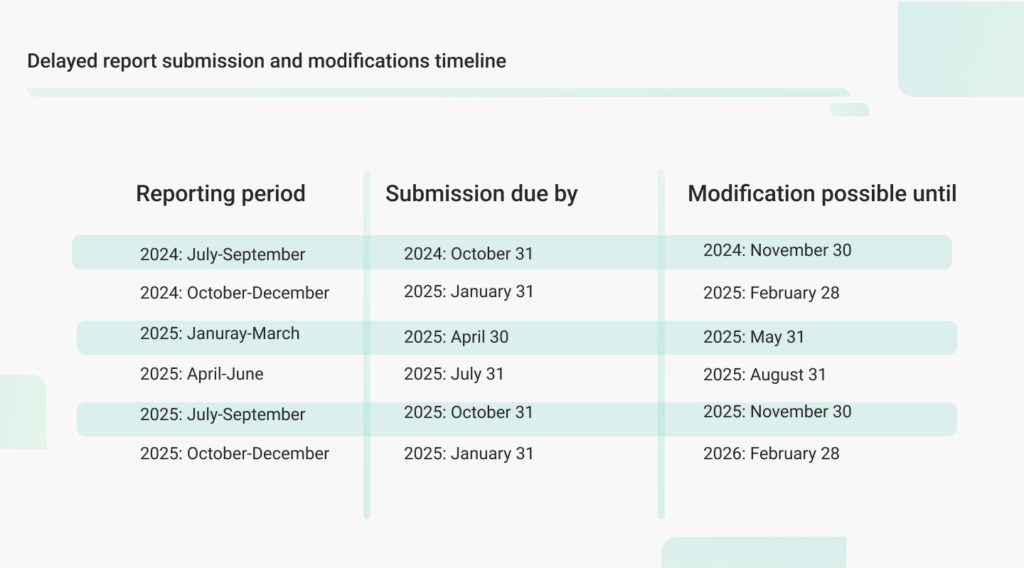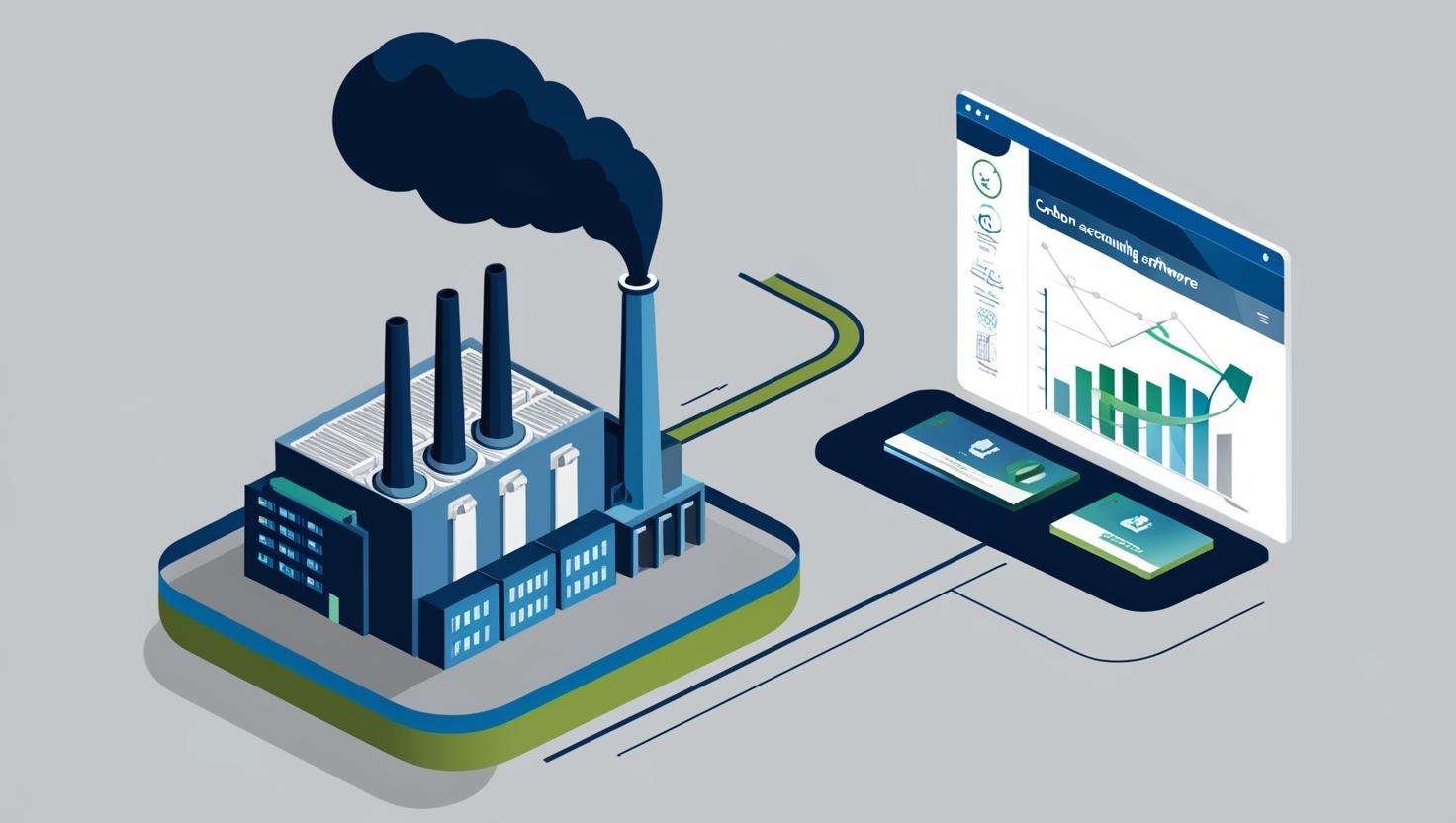Importers face multiple challenges in implementing the Carbon Border Adjustment Mechanism (CBAM) regarding data gathering and reporting. Moreover, EU importers deal with several challenges, including exporters’ data accuracy and correct use of the CBAM report filing template, among many others. However, importers can request a delayed report submission on the grounds of technical errors. The guidelines also allow for time-bound correction and appropriate modifications.
In this blog, we will look at the guidelines under which delayed submission can be allowed by the importers.
When can a delayed submission request be made?
As per EU’s CBAM guidelines, importers can delay report submissions only due to technical errors while submitting the report on the CBAM Transitional Registry. This delay is allowed for both the transitional phase 1 and the definitive regime. The request for delayed submission can only be placed by an importer who could not submit the CBAM quarterly reports on the deadline. Moreover, the request for delayed submissions of CBAM reports can only be approved by the competent authorities in the EU Member States. As per the CBAM guidelines, the EU provides the delayed submission request button after finding anomalies (technical errors) in the report submitted to the competent authorities. The request button for delayed submission can only be used by the importers. Moreover, the guidelines allow this only if the draft of the quarterly report was already created before the actual report submission due date (Example: 30/09/2024 for Q3-2024)

Meanwhile, after the delayed CBAM report submission request is made, importers will have 30 days to modify and submit the correct report. As per the CBAM guidelines to National Competent Authorities (NCAs), no penalties will be imposed on importers who have experienced challenges in submitting their first report or applying for first corrections.

Steps to request for delayed submission
- Step 1: The importer is required to access the declarant portal: https://cbam.ec.europa.eu/declarant/ Thereafter, importer must click on ‘My Quarterly Reports’ using the dashboard.
- Step 2: The importer shall click on the ‘Request Delayed Submission’ button and select the appropriate quarterly reporting option.
- Step 3: After the request delayed submission window is displayed, an option ‘Requested by NCA’ appears on the site.
- Step 4: Now, the importer shall provide the reference number as given by the NCA.
- Step 5: After giving the reference number, the importer is required to confirm the wish submit a report with delay.
- Step 6: After that, a pop-up message will be displayed where the importer is required to confirm the successful operation.
Step 7: After correctly following all these steps, the quarter will now open for submission, where the user can create and upload a quarterly report. Once this is done, the ‘Create’ button will be pressed, initiating the Quarterly Report creation.
3 reasons for technical error in CBAM report
There are three primary reasons that could cause technical errors in CBAM reports. Here is a look at them:
Data accuracy: There could be technical errors due to inaccurate data submitted to the importer by exporters. The exporters’ lack of a well-defined data collection and management system could result in issues related to data accuracy. Although the importers are responsible for checking and maintaining the data accuracy while submitting the report, they are also new to the CBAM reporting system. Hence, a minor mismatch in data at any level could mean technical errors in the final CBAM report submission.
Cross-verification of data: Importers have the responsibility of cross-checking the emissions data shared by the exporters. Ensuring data sharing and verification at a large scale results in a lot of complexities due to multiple layers of time-consuming coordination. This also means a lot of technical mismatches in report exchanges and submissions. Subsequently, it could also lead to technical errors in the CBAM report submission.
Incorrect reporting template: According to the CBAM guidelines, exporters and importers are required to follow specific templates and formats to enter data and submit the report on time. Ensuring this correction and maintaining that exporters submit the report in the given template could also result in technical errors, incorrect reporting, and last-minute changes and modifications. Incorrect use of reporting template and the technicalities in filing the emission reporting details also cause technical errors in CBAM reporting.
How can importer’s challenges be eliminated?
The primary challenge of the EU importer is to ensure the accuracy of embedded emissions data provided by the supplier stationed outside the Commission. Hence, importers must ensure the accuracy of emissions data submitted by exporters and trace back details of the manufacturing origins in non-EU countries. Additional difficulties arise in determining actual emissions, leading to credibility issues regarding data shared by operators. To successfully navigate CBAM compliance, importers must gather, manage, and process a substantial amount of emissions information from exporters outside the EU.
This necessitates digitising the entire data management process to achieve efficient outcomes and high-level data accuracy. Most challenges faced by importers can be mitigated by utilising comprehensive solutions such as The Sustainability Cloud, which offers an all-in-one platform to address issues related to CBAM compliance. Its comprehensive CBAM reporting tool allows enterprises to data collection, embedded emission calculations, reporting and auditing to ensure compliance.




